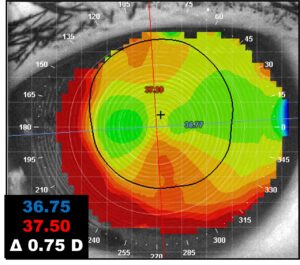When evaluating an over-refraction on a patient’s first diagnostic lens, have you ever wondered why there can be so much astigmatic cylinder? The cause might be lens flexure.
Researchers at Queensland University of Technology in Brisbane, Australia, studied the relationship between landing zone toricity and the flexure, rotation, and decentration of scleral lenses. Alexander and colleagues recruited ten normal subjects to evaluate scleral lenses with spherical haptics and toric landing zones of 100, 150, and 200 microns. (1)
Here’s what this research team found:
Who, what, and how they measured?
In this study, the left eyes of ten subjects were mapped with a scleral profilometer and corneal topographer to aid in determining the initial sagittal height of the lens. The goal was to ensure proper vaulting of at least 150 µm. The scleral toricity was also captured with profilometry. To determine scleral lens flexure, rotation and decentration an over-topography was captured. The landing zones tested on every subject included spherical, 100, 150 and 200 µm landing zones.
Scleral Shape of the Subjects:
All subjects had scleral toricity. Four had between 76-111 µm of scleral toricity while the remaining six had on average a little over 300 µm of scleral toricity at a 15 mm chord. Figure 1 shows an example of scleral lens toricity.
What about Flexure?
The flexure varied with the amount of toricity. Spherical landing zones on these toric scleras demonstrated on average 0.6 ± 0.27 Diopters of flexure. When the landing zone toricity increased, the amount of flexure decreased with only 0.22 ± 0.13 Diopters of flexure for the 200 µm toric lens. Figure 2 shows an example of 0.75 Diopters of flexure of a spherical scleral on a toric sclera.
How did Decentration and Rotation vary with the toricity?
Not surprisingly, the spherical lens rotated the most by 20 degrees compared to the toric landing zones. The horizontal decentration and vertical decentration didn’t vary much and was not statistically significant.
Piecing it All Together:
Fitting scleral lenses is a complex process and utilizing scleral profilometry can help you determine the necessary sagittal height and scleral toricity for the lenses. However, if you do not have access to a profilometer, visual cues from the slit lamp can guide you in adding scleral landing zone toricity. Scleral toricity helps stabilize lens rotation, particularly when front surface optical toricity is required.
Keep in mind that lens flexure can impact over-refraction by up to 0.87 Diopters, so we recommend starting with the spherical equivalent for your first lens to avoid unnecessary remakes due to residual astigmatism. Fewer remakes mean less chair time for both you and your patients. For more tips on reducing remakes, read our detailed guide.
Figure 1. A scleral lens with a toric landing zone. The steep (more curved) meridian is designated by the hashmark in the image.
Figure 2. A scleral lens with a spherical landing zone is mapped with a corneal topographer. An against-the-rule astigmatic topography is shown representing 0.75 Diopters of lens flexure. If there was no flexure the surface would be spherical.
- Alexander J, Belaineh Aweke Y, Bhebhe Z, Cho D, Lay S, Ryan I, et al. The effect of landing zone toricity on scleral lens fitting characteristics and optics. Ophthalmic Physiol Opt. 2024;44:867–875 https://doi.org/10.1111/opo.13324



